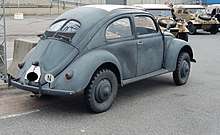Volkswagen Kommandeurswagen
The Volkswagen Typ 87, also known as the Kommandeurswagen, was a World War II, four-wheel-drive version of the Volkswagen Beetle.[1] It was produced from 1941 to 1944 by the Volkswagen plant, primarily for the Wehrmacht.[1] The Wehrmacht classified the Kommandeurswagen as leichter geländegängiger PKW, 4-sitziger, 4-radgetriebener Geländewagen Typ 87.[2] (light offroad passenger car, four seats, all wheel drive offroad vehicle Type 87). The drivetrain and the engine are the same as in the Volkswagen Typ 166 Schwimmwagen.[1] 564 units of the Kommandeurswagen were produced[3]; in November 1946[4], the Volkswagen plant produced two more vehicles. No new parts were produced for them; instead, old depot parts were used.
| Volkswagen Typ 87 | |
|---|---|
VW Typ 87 | |
| Overview | |
| Manufacturer | Volkswagenwerk GmbH |
| Also called | Kommandeurswagen |
| Production | 1941-1944 |
| Assembly | Stadt des KdF-Wagens |
| Designer | Ferdinand Porsche[1] |
| Body and chassis | |
| Class | Military vehicle |
| Body style | 2-door saloon |
| Layout | Rear engine, all wheel drive |
| Platform | VW Typ 166 / KdF-Wagen |
| Related | Volkswagen Typ 166 Schwimmwagen |
| Powertrain | |
| Engine | Otto (1131 cm3, 18 kW) |
| Transmission | 4+1-speed manual |
| Dimensions | |
| Wheelbase | 2,400 mm (94.5 in) |
| Length | 3,830 mm (150.8 in) |
| Width | 1,620 mm (63.8 in) |
| Height | 1,720 mm (67.7 in) |

Description
The Typ 87 is a 2-door offroad saloon. The visual appearance is similar to the KdF-Wagen, because the KdF-Wagen body was also used for the Typ 87. Due to the 5¼-16 offroad tyres, the wings had to be increased in size with an additional metal strip next to the bonnet and boot.[1] The running-board strips were also made wider.[5] While the boot of the KdF-Wagen holds a spare wheel in front of the fuel tank, the Typ 87 has an additional 20 l fuel canister instead at the same place. The spare wheel is located on top of the 40 l fuel tank, which has a modified filler neck.[5] Chassis and body are connected with screws. By default, the Kommandeurswagen has a sunroof.[5]
Like the VW Typ 166, the Typ 87 has a modified KdF-Wagen chassis.[1] The backbone tube was increased in diameter to hold the additional cardan shaft for the front wheel drive.[1] The steering knuckles were modified for the drive shaft.[1] A worm and sector steering was used.[2] The rear axle is equipped with reduction gears, both front and rear axle differentials are lockable.[1] A single disc dry clutch[2] transmits the torque from the engine to the manual four-speed gearbox which is equipped with an additional offroad gear.[1] The offroad gear is activated with a lever, as well as the front wheel drive.[1] With activated front wheel drive, the top speed is 10 km/h (6 mph) and the maximum slope climbing angle is 33.75°. The Typ 87 is powered by an air-cooled flat-four-cylinder-otto engine with a displacement of 1131 cm3 and a rated power of 18 kW (24 hp).[5]
Vehicles made for the German Africa Corps were often equipped with the tropic equipment. The tropic equipment protects the air filter, the carburettor and the electrics from dust.[5] In addition to that, sand tyres are also a part of the tropic equipment. Those tyres are called Kronprinzräder.[6]
Technical Data
| Engine | |
|---|---|
| Engine layout | Four-cylinder, flat-engine (Otto) |
| Cooling | Air-cooling with fan |
| Valvetrain | OHV |
| Fuel system | Carburettor Solex 26 VF3 |
| Firing order | 1-4-3-2 |
| Bore × Stroke | 75 mm × 64 mm |
| Displacement | 1131 cm3 |
| Rated power | 18 kW (24 hp) at 3000 min−1 |
| Drivetrain | |
| Clutch | Single disc dry clutch Fichtel & Sachs K10 |
| Gearbox | Porsche 4-speed gearbox with additional offroad and reverse gear |
| Drive | Rear wheel drive with switchable front wheel drive and locking differentials |
| Chassis | |
| Frame | Backbone tube chassis |
| Front springs | Torsion bar |
| Rear springs | |
| Steering | Worm and sector |
| Brake system | Drum brakes |
| Tyres | front and rear 5,25-16 or 200-16 |
| Dimensions and weights | |
| Dimensions (L × W × H) | 3,830 mm (150.8 in) × 1,620 mm (63.8 in) × 1,720 mm (67.7 in) |
| Ground clearance | 255 mm (10.0 in) |
| Wheelbase | 2,400 mm (94.5 in) |
| Track width | front: 1,356 mm (53.4 in) rear: 1,360 mm (53.5 in) |
| Turning radius | 5 m |
| Max. allowed weight | 1,240 kg (2,734 lb) |
| Max. payload | 450 kg (992 lb) |
| Additional data | |
| Fuel consumption | 8.5 l/100 km |
| Oil consumption | 0.12 l/100 km |
| Fuel tank | 40 l + 20 l canister |
| Top speed | 80 km/h (50 mph) |
| Battery | Lead-acid, 6 V, 75 Ah |
| Starter | Bosch EED 0,4/6 |
| Generator | Bosch REDK 130/6/2600 |
| Source | [2] |
References
- Mayer, page 30
- Mayer, page 34
- Mayer, page 33
- Mayer, page 47
- Mayer, page 32
- Mayer, page 31
Bibliography
| Wikimedia Commons has media related to Volkswagen Kommandeurswagen. |
- Hans-Georg Mayer: Der VW-Käfer im Kriege und im militärischen Einsatz danach. Band 114 aus der Reihe Waffen-Arsenal, Podzun-Pallas-Verlag, Dorheim 1988, ISBN 3-7909-0357-4. Page 30–34